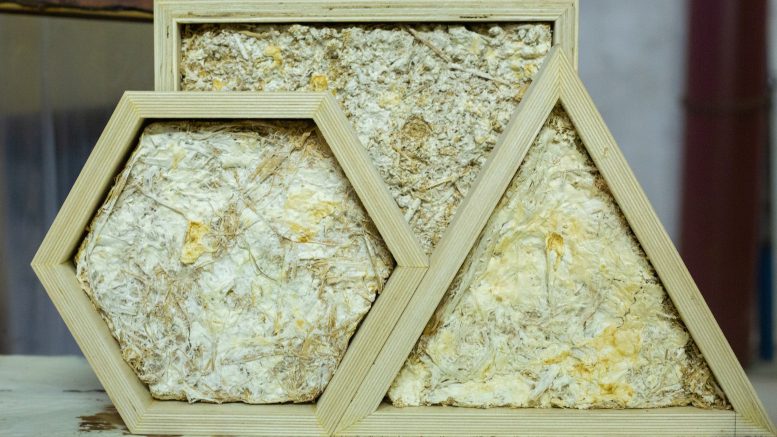Nature is resilient.
The natural world has the ability to self-renew, self-repair and maintain function despite disturbances.
Biomimetic designs draw abstract lessons from nature and use them as a source of inspiration in various systems.
This is the foundation of U of M assistant professor in the faculty of architecture Mercedes Garcia-Holguera’s research.
“We are trying to learn from nature,” she said.
Garcia-Holguera began experimenting using biomaterials during the COVID-19 pandemic, focusing on two specific biological sources — mycelium, a network of fungal fibres, and bacterial cellulose, a biomaterial synthesized by bacteria — in developing materials for architectural projects in construction.
She said that the goal of the research is to reduce the environmental impact of buildings, explaining that, regarding the environment, “buildings are responsible for a huge amount of our problems.”
“We as designers need to take responsibility for that,” she said.
A substantial challenge, in which biomaterials could serve as a potential solution, is the high cost and inaccessibility of construction materials in remote Northern communities.
One of the things Garcia-Holguera focuses on in her testing is whether biomaterials can be grown in non-specialized and less controlled environments, outside of the laboratory. This could potentially tackle the housing crisis experienced in remote communities.
“If we can grow those materials in those conditions, it is more reasonable to think that we will be able to grow them in these remote communities and the people in these communities will be able to grow these materials themselves,” she said.
The mycelium-based materials, for instance, are grown in a standard non-controlled space at the Fort Garry campus.
Using a two-stage growth process, Garcia-Holguera and her team inoculate agricultural or industrial waste products like sawdust and straw with mycelium. This inoculated mix is allowed to grow in a humidity-controlled bag, until it is fully colonized by the mycelium.
The substrate is then transferred to a mould, where it grows for a few weeks before it is subsequently oven-dried to become ready for use.
Unlike mycelium, the bacterial cellulose materials have a different growth process which Garcia-Holguera described as resembling the fermentation process of kombucha.
According to Garcia-Holguera, both mycelium and bacterial cellulose materials have significant potential for improved environmental performance when compared to traditional materials used in present-day construction.
Mycelium based materials integrate industrial waste such as sawdust, as well as agricultural waste products such as hemp or straw, which are abundant in the province.
Not only does this recycle waste products, but these new materials are biodegradable and less harmful to the environment when degraded. They also require much less energy in production than materials like steel or concrete.
Past research shows that these products have insulating potential and good compression strength, making them a viable substitute for traditional construction materials like bricks.
On the other hand, Garcia-Holguera believes that bacterial cellulose material has great potential as a tensile element and could be used to replace materials like cables and ropes.
Although minimal research has been conducted regarding the architectural applications of bacterial cellulose material, Garcia-Holguera and her team are testing how these materials perform in the weather conditions of both Winnipeg and Churchill, Man.
“Our expectations back then, when we put the samples out, was that the samples will be destroyed or broken very quickly, but that is not what we are seeing,” she explained.
“They are maintaining their integrity. They are able to negotiate with the environment, like humidity and changes in temperature.”
Currently, the team is developing a three-metre dome using larger panels derived from bacterial cellulose.
“The conditions and the exposition to the weather will be much more drastic, and we will be able to see if still at a larger scale, these materials will still behave well,” Garcia-Holguera said.
An important aspect of Garcia-Holguera’s research involves changing the general public mindset that buildings are permanent structures intended to last as long as possible. Rather, by using biomaterials in designing buildings, certain building elements can be maintained on a regular basis.
To Garcia-Holguera, this concept is more attuned to natural cycles and how ecosystems renew seasonally.
Garcia-Holguera said that the next step in her team’s research will involve increasing the scale of the biomaterials used in their projects.
The team is planning to create a shelter-like prototype within the next year to test the weathering performance and hypothermal and mechanical properties of the biomaterials in the Manitoba climate.
Garcia-Holguera emphasized the importance of student participation and collaboration in her research.
“The work that we do, it’s impossible to do without the students,” she said. “The students are key.”
“You need a team, and you need a team that is passionate.”


